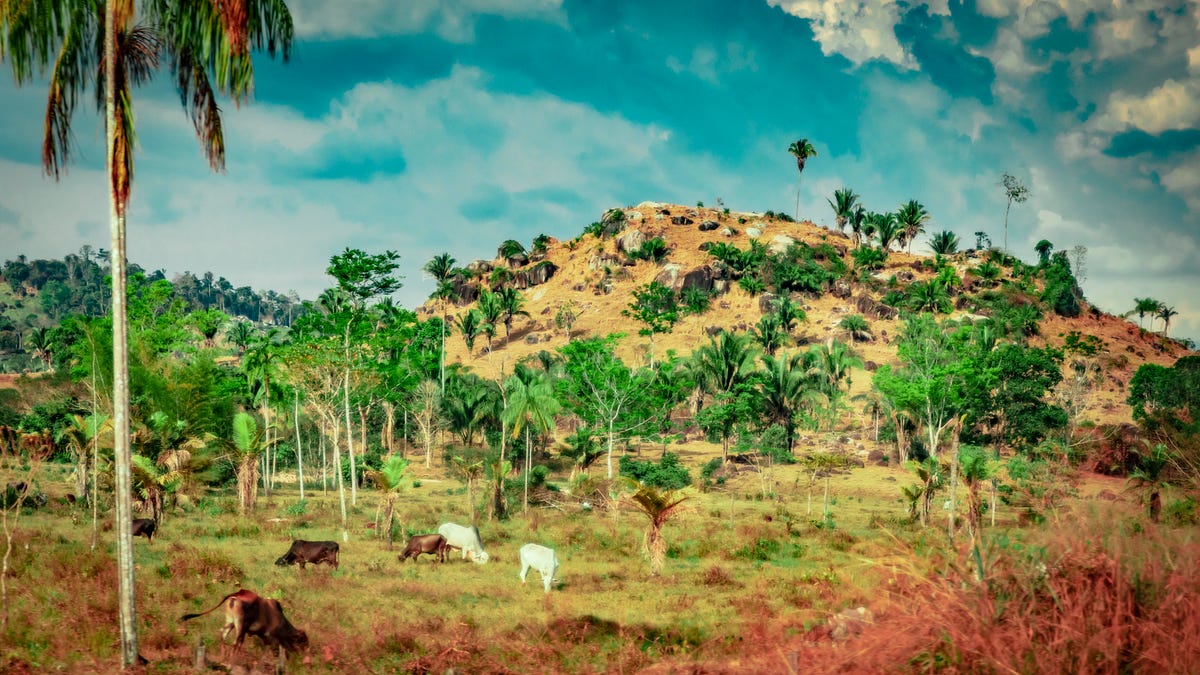The Surui take on a challenge as big as the Amazon
This indigenous tribe in Brazil is defending the world's biggest rainforest.

Deforestation in the Amazon has many causes. It started with mining and logging, then moved onto slash-and-burn forest clearing for agriculture.
Unfortunately, the Amazon's shallow soil quickly loses nutrients, causing crops to fail after just a few years. That often forces farmers to convert land to cattle pasture and then cut down more forest to cultivate crops.
See the full story: The True People of the Amazon help save the world
This is a makeshift wood-processing facility on the outskirts of the Surui tribe's territory. The tribe named its land after the date of its first contact with the modern world: the Seventh of September.
People collect palm fronds from the jungle to be used for roofs on some village homes and for making baskets.
A member of the Surui tribe goes on patrol in a remote part of Mato Grosso. He's looking for evidence of illegal mining and logging that he can report to the authorities.
This is a chief of the Paiter-Surui tribe, Almir Narayamoga Surui.
Almir's mission is to ensure the Seventh of September stays intact.
Before making contact with the outside world in 1969, the Surui would fight off invaders with bow and arrow. Chief Almir has taken a different approach: He's turned to Google Earth to get satellite images of illegal clear-cutting and mining operations.
Almir pulls up Google Earth on his smartphone, then zooms in on the Seventh of September to look more closely at an illegal gold mine.
When you enter the Seventh of September, the farmland shrinks away and the dry air becomes humid. The dirt road turns a dark brick red.
This is Lapetanha, Chief Almir's hometown. The small village of about 75 people boasts electricity, running water, a health clinic and a school. A 12-story steel tower in the center of town brings Wi-Fi to the villagers.
Many of the Surui still hunt with bow and arrow.
A scene of village life in Lapetanha.
A young boy watches Batman videos on YouTube while the adults sit around and talk.
Time seems to pass more slowly here.
Several of the common areas in Lapetanha have open air structures topped with thatch and strung with hammocks.
The Surui know every square foot of the Seventh of September. They can identify all of the trees and animals and have names for every river and creek.
A Surui man takes aim with a longbow and arrow.
At the Surui's district headquarters in Cacoal, Brazil, CNET's Dara Kerr (second from right) looks at mapping data the tribe uses to monitor deforestation.
This is what the Amazon looks like when untouched by deforestation. It's no wonder early explorers nicknamed the rainforest the "Green Hell."
Google helped train the Surui on using mapping tools. It also added information about the Surui and the Seventh of September to Google Earth. People can now zoom in on the territory to see photos and learn about the Surui's culture and history.
Along the remote highways in Rondonia, the rainforest's green landscape fades into dusty barren land.
Almost all of Rondonia was once thick with jungle. Now, there's a stark line between deforested land and the rainforest.
The Surui are in constant danger as they struggle to defend themselves and their culture.
"We are honestly under threat from loggers' and miners' guns," Almir wrote in 2016.
Here, Almir walks through the jungle with his shotgun in hand while on patrol in search of any evidence of incursions into the tribal territory.
Loggers primarily go after the Brazil nut tree, which grows perfectly straight and can reach 200 feet tall. We came across this makeshift wood factory in a remote area of Mato Grosso.
The Surui use 4x4 pickup trucks to go on patrol in the rainforest. They're looking for evidence of mining, logging and other illegal activities in their territory.
A wood processing facility in Mato Grosso.
It's not easy driving through the plant-choked, rugged tracks of the rainforest. It took an hour of collective engineering to free this 4x4 from a muddy ditch during one excursion.
In the heart of what's called the "arc of deforestation," Rondonia is the most deforested state in Brazil's Amazon, according to the World Wildlife Fund.
Deep in Mato Grosso, we turn off the dusty road and Almir drives the pickup up a small hill and into the forest, parking just far enough in to hide his truck among the trees.
We arrive at a makeshift camp where the tribe has already strung hammocks and set up tents.
A member of the Surui prepares a campfire while out on patrol in the northern section of the tribe's territory.
In all, 28 people are camping here. Tomorrow, we'll walk into the forest on patrol to look for evidence of illegal mining and logging.
The jungle is constantly moving. Scarlet macaws fly overhead as monkeys hop from tree to tree.
CNET senior reporter Dara Kerr (left), Almir Narayamoga Surui, chief of one of the four clans of the Paiter-Surui tribe (center), and CNET senior photographer James Martin (right), in Lapetanha, Brazil.
See the full story: The True People of the Amazon help save the world

